Nanoparticulate Perovskites for Photocatalytic Water Reduction
Abstract
:1. Introduction
2. Materials and Methods
2.1. General
2.2. Experimental
2.2.1. Nanoparticle Surface Activation Using HNO3 (SrTiO3-a, BaTiO3-a)
2.2.2. Nanoparticle Surface Activation Using H2O2 (SrTiO3-OH, BaTiO3-OH)
2.2.3. Nanoparticle Surface Ligand Functionalization (1@SrTiO3, 1@SrTiO3-a, 1@SrTiO3-OH, 1@BaTiO3, 1@BaTiO3-a, 1@BaTiO3-OH)
2.2.4. Nanoparticle Surface Complexation (Ru@SrTiO3, Ru@BaTiO3)
2.2.5. Nanoparticle Surface Complexation (rR@SrTiO3, rR@SrTiO3-a, rR@SrTiO3-OH, rR@SrTiO3-OH-A, rR@BaTiO3, rR@BaTiO3-a, rR@BaTiO3-OH, rR@BaTiO3-OH-A)
2.2.6. Dihydrogen Generation
3. Results and Discussion
3.1. NP Activation, Functionalization, Surface Complexation, and Material Characterization
3.1.1. NP Surface Activation
3.1.2. Nanoparticle Surface Ligand Functionalization
3.1.3. Nanoparticle Surface Complexation
3.2. Dihydrogen Generation from Water
General Procedure
4. Conclusions
Supplementary Materials
Author Contributions
Funding
Data Availability Statement
Acknowledgments
Conflicts of Interest
References
- Available online: https://www.ipcc.ch/sr15/download/#full (accessed on 4 November 2022).
- Available online: https://www.giss.nasa.gov/projects/impacts/ (accessed on 4 November 2022).
- Available online: https://climate.nasa.gov/news/2865/a-degree-of-concern-why-global-temperatures-matter (accessed on 4 November 2022).
- Solomon, S.; Plattner, G.-K.; Knutti, R.; Friedlingstein, P. Irreversible climate change due to carbon dioxide emissions. Proc. Natl. Acad. Sci. USA 2009, 106, 1704–1709. [Google Scholar] [CrossRef] [PubMed]
- Raftery, A.E.; Zimmer, A.; Frierson, D.M.W.; Startz, R.; Liu, P. Less than 2 °C warming by 2100 unlikely. Nat. Clim. Change 2017, 7, 637–641. [Google Scholar] [CrossRef] [PubMed]
- Kang, J.-N.; Wei, Y.-M.; Liu, L.-C.; Han, R.; Yu, B.-Y.; Wang, J.-W. Energy systems for climate change mitigation: A systematic review. Appl. Energy 2020, 263, 114602. [Google Scholar] [CrossRef]
- Rivard, E.; Trudeau, M.; Zaghib, K. Hydrogen Storage for Mobility: A Review. Materials 2019, 12, 1973. [Google Scholar] [CrossRef] [Green Version]
- Johnson, T.C.; Morris, D.J.; Wills, M. Hydrogen generation from formic acid and alcohols using homogeneous catalysts. Chem. Soc. Rev. 2010, 39, 81–88. [Google Scholar] [CrossRef]
- Chen, S.; Takata, T.; Domen, K. Particulate photocatalysts for overall water splitting. Nat. Rev. Mater. 2017, 2, 17050. [Google Scholar] [CrossRef]
- Mei, B.; Han, K.; Mul, G. Driving Surface Redox Reactions in Heterogeneous Photocatalysis: The Active State of Illuminated Semiconductor-Supported Nanoparticles during Overall Water-Splitting. ACS Catal. 2018, 8, 9154–9164. [Google Scholar] [CrossRef] [Green Version]
- Chen, Y.; Wang, M.; Xiang, S.; Liu, J.; Feng, S.; Wang, C.; Zhang, N.; Feng, T.; Yang, M.; Zhang, K.; et al. Hierarchical Hollow Nanocages Derived from Polymer/Cobalt Complexes for Electrochemical Overall Water Splitting. ACS Sustain. Chem. Eng. 2019, 7, 10912–10919. [Google Scholar] [CrossRef]
- Wang, Z.; Li, C.; Domen, K. Recent developments in heterogeneous photocatalysts for solar-driven overall water splitting. Chem. Soc. Rev. 2019, 48, 2109–2125. [Google Scholar] [CrossRef]
- Maleki, A.; Taheri-Ledari, R.; Ghalavand, R.; Firouzi-Haji, R. Palladium-decorated o-phenylenediamine-functionalized Fe3O4/SiO2 magnetic nanoparticles: A promising solid-state catalytic system used for Suzuki–Miyaura coupling reactions. J. Phys. Chem. 2020, 136, 109200. [Google Scholar] [CrossRef]
- Hassan, A.F.; Elhadidy, H. Effect of Zr+4 doping on characteristics and sonocatalytic activity of TiO2/carbon nanotubes composite catalyst for degradation of chlorpyrifos. J. Phys. Chem. 2019, 129, 180–187. [Google Scholar] [CrossRef]
- Sajjadi, S.; Khataee, A.; Darvishi Cheshmeh Soltani, R.; Hasanzadeh, A. N, S co-doped graphene quantum dot–decorated Fe3O4 nanostructures: Preparation, characterization and catalytic activity. J. Phys. Chem. 2019, 127, 140–150. [Google Scholar] [CrossRef]
- Stevens, P.D.; Fan, J.; Gardimalla, H.M.R.; Yen, M.; Gao, Y. Superparamagnetic Nanoparticle-Supported Catalysis of Suzuki Cross-Coupling Reactions. Org. Lett. 2005, 7, 2085–2088. [Google Scholar] [CrossRef] [PubMed]
- Adriano Zecchina, S.B.; Groppo, E. Selective Nanocatalysts and Nanoscience: Concepts for Heterogeneous and Homogeneous Catalysis; Wiley: Weinheim, Germany, 2011. [Google Scholar]
- Samira Bagheri, N.M.J. Nanocatalysts in Environmental Applications; Springer: Cham, Switzerland, 2018. [Google Scholar]
- Albonetti, S.; Mazzoni, R.; Cavani, F. Ch. 1 Homogeneous, Heterogeneous and Nanocatalysis. In Transition Metal Catalysis in Aerobic Alcohol Oxidation; Cardona, F., Parmeggiani, C., Eds.; Green Chemistry Series; RSC: New York, NY, USA, 2015; pp. 1–39. [Google Scholar]
- Freimann, S.A.; Housecroft, C.E.; Constable, E.C. Attraction in Action: Reduction of Water to Dihydrogen Using Surface-Functionalized TiO2 Nanoparticles. Nanomaterials 2022, 12, 789. [Google Scholar] [CrossRef] [PubMed]
- Emsley, J. The Elements, 3rd ed.; Oxford University Press Inc.: New York, NY, USA, 1994. [Google Scholar]
- Available online: https://pubs.usgs.gov/pp/0440d/report.pdf (accessed on 17 October 2022).
- Ober, J.A.; McRae, M.E.; Gambogi, J. Mineral Commodity Summaries 2021; U.S. Geological Survey: Reston, VA, USA, 2021; p. 200. [Google Scholar]
- Konstas, P.-S.; Konstantinou, I.; Petrakis, D.; Albanis, T. Development of SrTiO3 Photocatalysts with Visible Light Response Using Amino Acids as Dopant Sources for the Degradation of Organic Pollutants in Aqueous Systems. Catalysts 2018, 8, 528. [Google Scholar] [CrossRef] [Green Version]
- Kappadan, S.; Gebreab, T.W.; Thomas, S.; Kalarikkal, N. Tetragonal BaTiO3 nanoparticles: An efficient photocatalyst for the degradation of organic pollutants. Mater. Sci. Semicond. Process 2016, 51, 42–47. [Google Scholar] [CrossRef]
- Xiong, X.; Tian, R.; Lin, X.; Chu, D.; Li, S. Formation and Photocatalytic Activity of BaTiO3 Nanocubes via Hydrothermal Process. J. Nanomater. 2015, 2015, 692182. [Google Scholar] [CrossRef] [Green Version]
- Konta, R.; Ishii, T.; Kato, H.; Kudo, A. Photocatalytic Activities of Noble Metal Ion Doped SrTiO3 under Visible Light Irradiation. J. Phys. Chem. B 2004, 108, 8992–8995. [Google Scholar] [CrossRef]
- Rohj, R.K.; Hossain, A.; Mahadevan, P.; Sarma, D.D. Band Gap Reduction in Ferroelectric BaTiO3 through Heterovalent Cu-Te Co-Doping for Visible-Light Photocatalysis. Front. Chem. 2021, 9, 682979. [Google Scholar] [CrossRef]
- Chen, P.; Li, X.; Ren, Z.; Wu, J.; Li, Y.; Liu, W.; Li, P.; Fu, Y.; Ma, J. Enhancing Photocatalysis of Ag Nanoparticles Decorated BaTiO3 Nanofibers through Plasmon-Induced Resonance Energy Transfer Turned by Piezoelectric Field. Catalysts 2022, 12, 987. [Google Scholar] [CrossRef]
- Ma, L.; Sun, T.; Cai, H.; Zhou, Z.-Q.; Sun, J.; Lu, M. Enhancing photocatalysis in SrTiO3 by using Ag nanoparticles: A two-step excitation model for surface plasmon-enhanced photocatalysis. J. Chem. Phys. 2015, 143, 084706. [Google Scholar] [CrossRef] [PubMed]
- Jiang, J.; Kato, K.; Fujimori, H.; Yamakata, A.; Sakata, Y. Investigation on the highly active SrTiO3 photocatalyst toward overall H2O splitting by doping Na ion. J. Catal. 2020, 390, 81–89. [Google Scholar] [CrossRef]
- Lyu, H.; Hisatomi, T.; Goto, Y.; Yoshida, M.; Higashi, T.; Katayama, M.; Takata, T.; Minegishi, T.; Nishiyama, H.; Yamada, T.; et al. An Al-doped SrTiO3 photocatalyst maintaining sunlight-driven overall water splitting activity for over 1000 h of constant illumination. Chem. Sci. 2019, 10, 3196–3201. [Google Scholar] [CrossRef] [Green Version]
- Alex, K.V.; Prabhakaran, A.; Jayakrishnan, A.R.; Kamakshi, K.; Silva, J.P.B.; Sekhar, K.C. Charge Coupling Enhanced Photocatalytic Activity of BaTiO3/MoO3 Heterostructures. ACS Appl. Mater. Interfaces 2019, 11, 40114–40124. [Google Scholar] [CrossRef] [PubMed]
- Fazli, A.; Zakeri, F.; Khataee, A.; Orooji, Y. A BaTiO3/WS2 composite for piezo-photocatalytic persulfate activation and ofloxacin degradation. Commun. Chem. 2022, 5, 95. [Google Scholar] [CrossRef]
- Yadav, A.A.; Hunge, Y.M.; Mathe, V.L.; Kulkarni, S.B. Photocatalytic degradation of salicylic acid using BaTiO3 photocatalyst under ultraviolet light illumination. J. Mater. Sci. Mater. 2018, 29, 15069–15073. [Google Scholar] [CrossRef]
- Kato, K.; Jiang, J.; Sakata, Y.; Yamakata, A. Effect of Na-Doping on Electron Decay Kinetics in SrTiO3 Photocatalyst. ChemCatChem 2019, 11, 6349–6354. [Google Scholar] [CrossRef]
- Qin, Y.; Fang, F.; Xie, Z.; Lin, H.; Zhang, K.; Yu, X.; Chang, K. La,Al-Codoped SrTiO3 as a Photocatalyst in Overall Water Splitting: Significant Surface Engineering Effects on Defect Engineering. ACS Catal. 2021, 11, 11429–11439. [Google Scholar] [CrossRef]
- Moss, B.; Wang, Q.; Butler, K.T.; Grau-Crespo, R.; Selim, S.; Regoutz, A.; Hisatomi, T.; Godin, R.; Payne, D.J.; Kafizas, A.; et al. Linking in situ charge accumulation to electronic structure in doped SrTiO3 reveals design principles for hydrogen-evolving photocatalysts. Nat. Mater. 2021, 20, 511–517. [Google Scholar] [CrossRef]
- Fan, Y.; Liu, Y.; Cui, H.; Wang, W.; Shang, Q.; Shi, X.; Cui, G.; Tang, B. Photocatalytic Overall Water Splitting by SrTiO3 with Surface Oxygen Vacancies. Nanomaterials 2020, 10, 2572. [Google Scholar] [CrossRef]
- Maeda, K. Rhodium-Doped Barium Titanate Perovskite as a Stable p-Type Semiconductor Photocatalyst for Hydrogen Evolution under Visible Light. ACS Appl. Mater. Interfaces 2014, 6, 2167–2173. [Google Scholar] [CrossRef]
- Fujisawa, J.-I.; Eda, T.; Hanaya, M. Comparative study of conduction-band and valence-band edges of TiO2, SrTiO3, and BaTiO3 by ionization potential measurements. Chem. Phys. Lett. 2017, 685, 23–26. [Google Scholar] [CrossRef]
- Liao, D.L.; Wu, G.S.; Liao, B.Q. Zeta potential of shape-controlled TiO2 nanoparticles with surfactants. Colloids Surf. 2009, 348, 270–275. [Google Scholar] [CrossRef]
- Bhagya, N.P.; Prashanth, P.A.; Raveendra, R.S.; Sathyanarayani, S.; Ananda, S.; Nagabhushana, B.M.; Nagabhushana, H. Adsorption of hazardous cationic dye onto the combustion derived SrTiO3 nanoparticles: Kinetic and isotherm studies. J. Asian Ceram. Soc. 2016, 4, 68–74. [Google Scholar] [CrossRef] [Green Version]
- Cai, J.; Wei, H.; Zhang, Y.; Cai, R.; Zhang, X.; Wang, Y.; Liu, J.; Tan, H.H.; Xie, T.; Wu, Y. Designed Construction of SrTiO3/SrSO4/Pt Heterojunctions with Boosted Photocatalytic H2 Evolution Activity. Eur. J. Chem. 2021, 27, 7300–7306. [Google Scholar] [CrossRef]
- Olhero, S.M.; Kaushal, A.; Ferreira, J.M.F. Preventing hydrolysis of BaTiO3 powders during aqueous processing and of bulk ceramics after sintering. J. Eur. Ceram. Soc. 2015, 35, 2471–2478. [Google Scholar] [CrossRef] [Green Version]
- Luan, W.; Gao, L. Influence of pH value on properties of nanocrystalline BaTiO3 powder. Ceram. Int. 2001, 27, 645–648. [Google Scholar] [CrossRef]
- Ye, H.-J.; Shao, W.-Z.; Zhen, L. Tetradecylphosphonic acid modified BaTiO3 nanoparticles and its nanocomposite. Colloids Surf. A Physicochem. Eng. Asp. 2013, 427, 19–25. [Google Scholar] [CrossRef]
- Rechberger, F.; Ilari, G.; Willa, C.; Tervoort, E.; Niederberger, M. Processing of Cr doped SrTiO3 nanoparticles into high surface area aerogels and thin films. Mater. Chem. Front. 2017, 1, 1662–1667. [Google Scholar] [CrossRef]
- Čulić-Viskota, J.; Dempsey, W.P.; Fraser, S.E.; Pantazis, P. Surface functionalization of barium titanate SHG nanoprobes for in vivo imaging in zebrafish. Nat. Protoc. 2012, 7, 1618–1633. [Google Scholar] [CrossRef]
- Pujari, S.P.; Scheres, L.; Marcelis, A.T.M.; Zuilhof, H. Covalent Surface Modification of Oxide Surfaces. Angew. Chem. Int. Ed. Engl. 2014, 53, 6322–6356. [Google Scholar] [CrossRef] [PubMed]
- Kim, B.; Park, S.W.; Kim, J.-Y.; Yoo, K.; Lee, J.A.; Lee, M.-W.; Lee, D.-K.; Kim, J.Y.; Kim, B.; Kim, H.; et al. Rapid Dye Adsorption via Surface Modification of TiO2 Photoanodes for Dye-Sensitized Solar Cells. ACS Appl. Mater. Interfaces 2013, 5, 5201–5207. [Google Scholar] [CrossRef] [PubMed]
- Freimann, S.A.; Zare, D.; Housecroft, C.E.; Constable, E.C. The SALSAC approach: Comparing the reactivity of solvent-dispersed nanoparticles with nanoparticulate surfaces. Nanoscale Adv. 2020, 2, 679–690. [Google Scholar] [CrossRef] [PubMed]
- Freimann, S.A.; Prescimone, A.; Housecroft, C.E.; Constable, E.C. Turning over on sticky balls: Preparation and catalytic studies of surface-functionalized TiO2 nanoparticles. RSC Adv. 2021, 11, 5537–5547. [Google Scholar] [CrossRef]
- Available online: https://webbook.nist.gov/cgi/cbook.cgi?ID=C7664939&Mask=200#Mass-Spec (accessed on 17 October 2022).
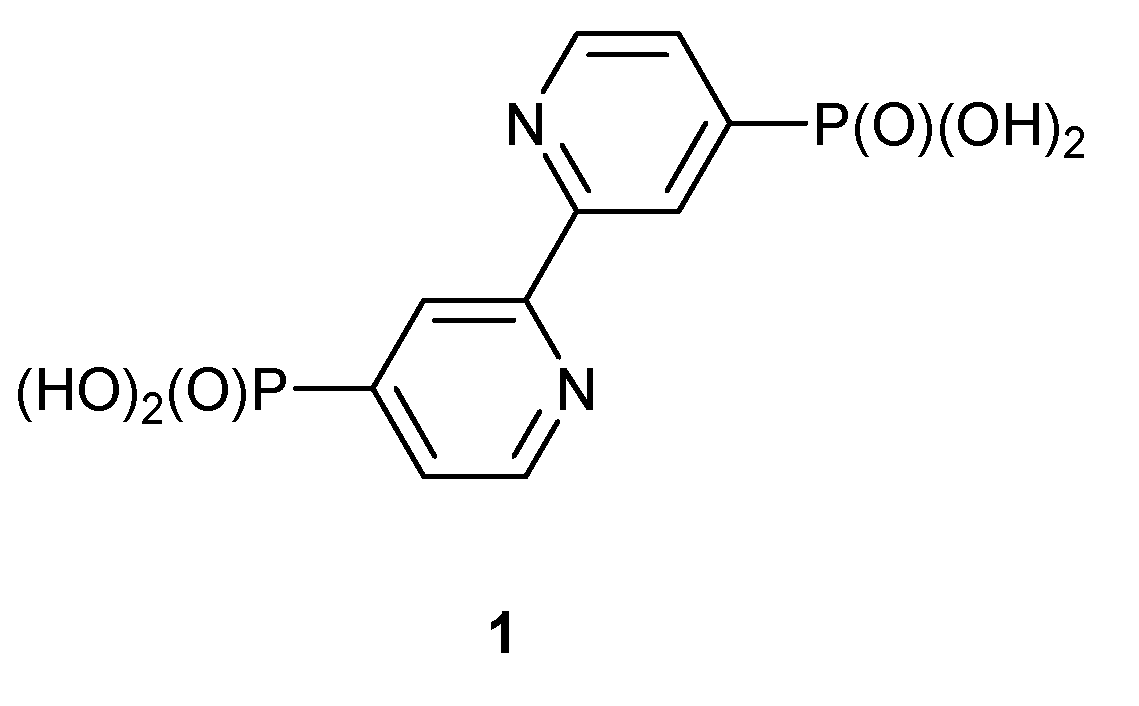
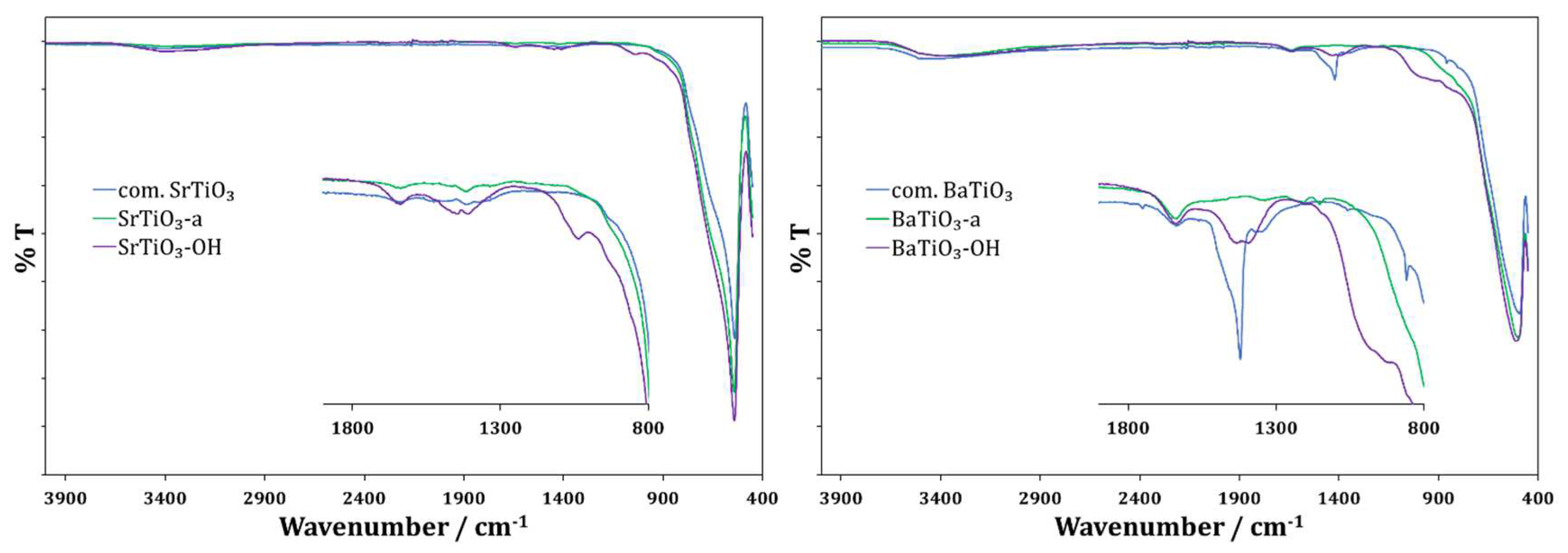
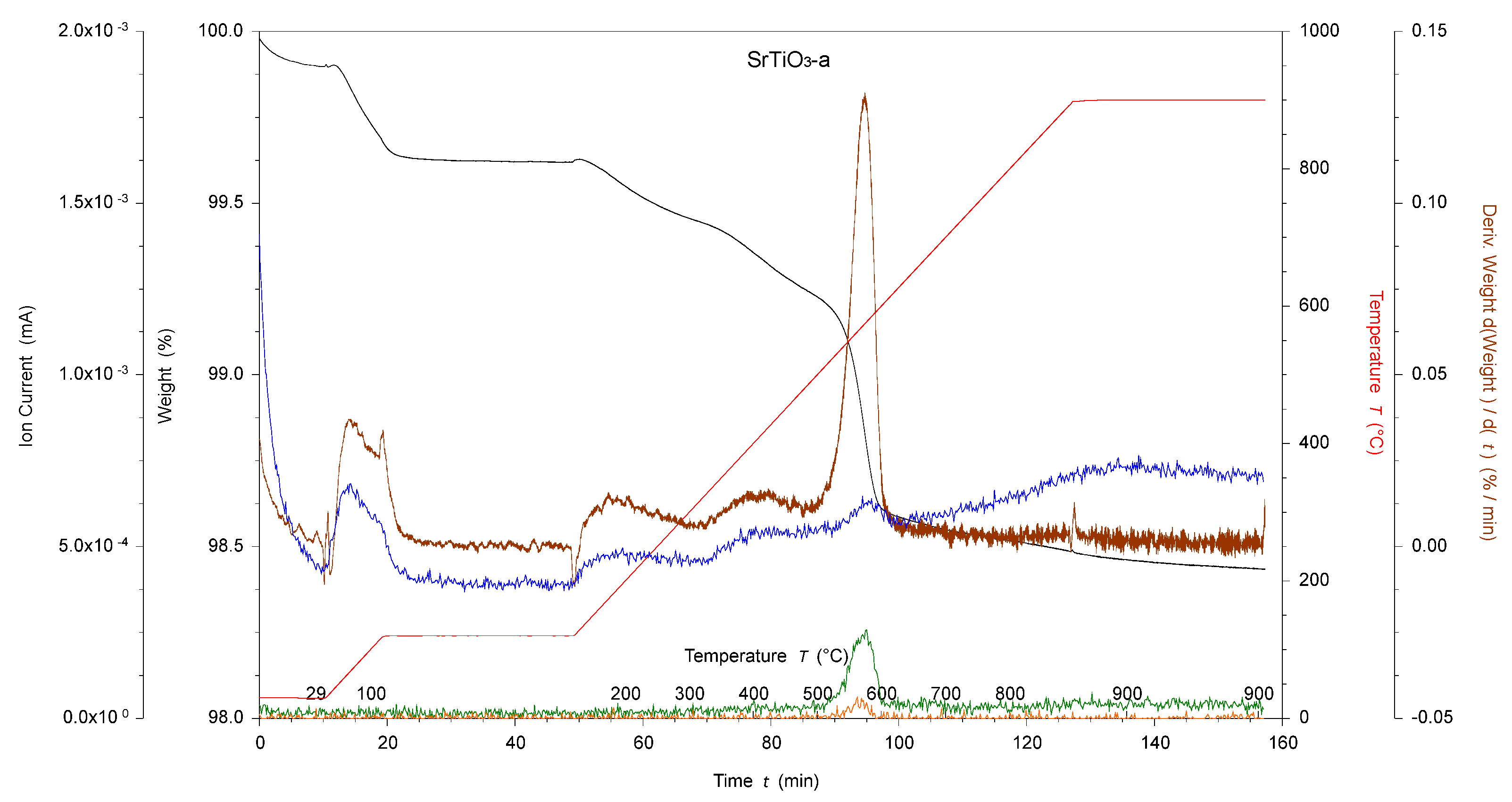
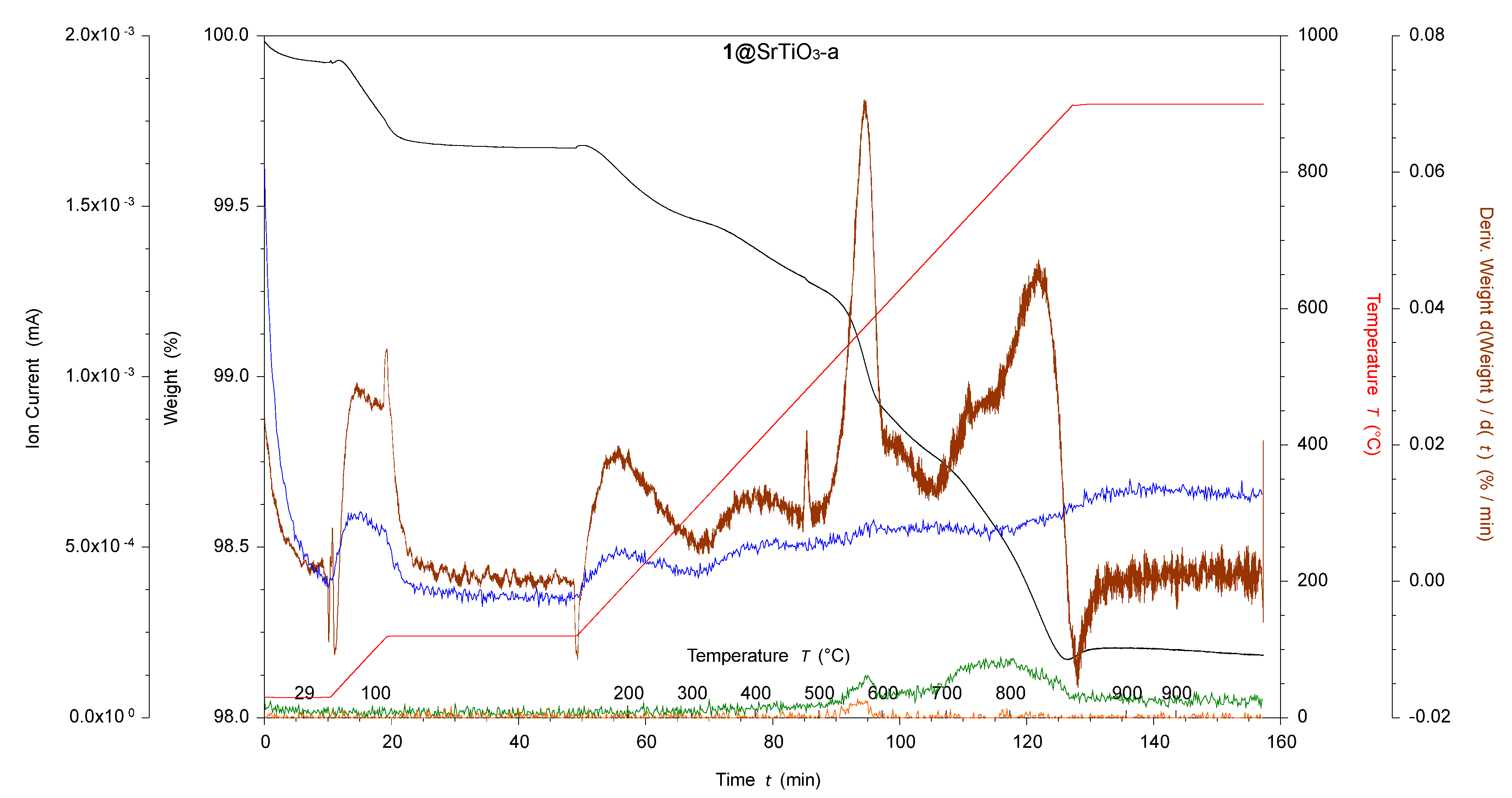
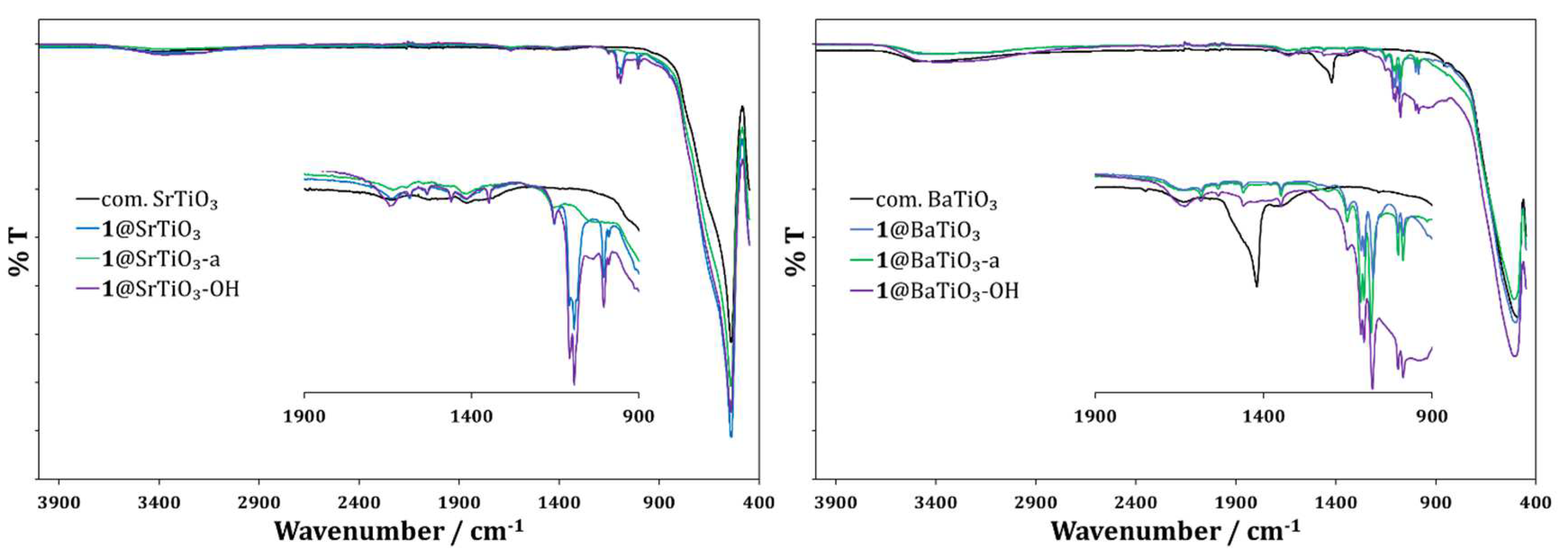
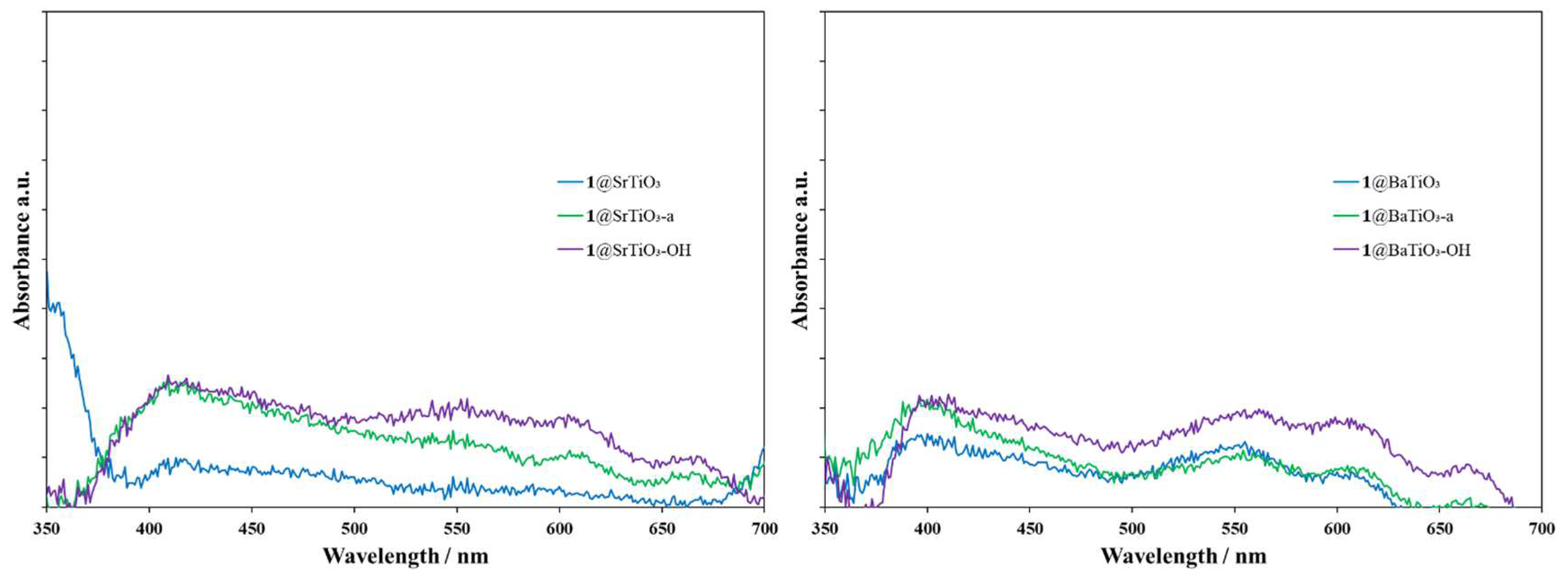

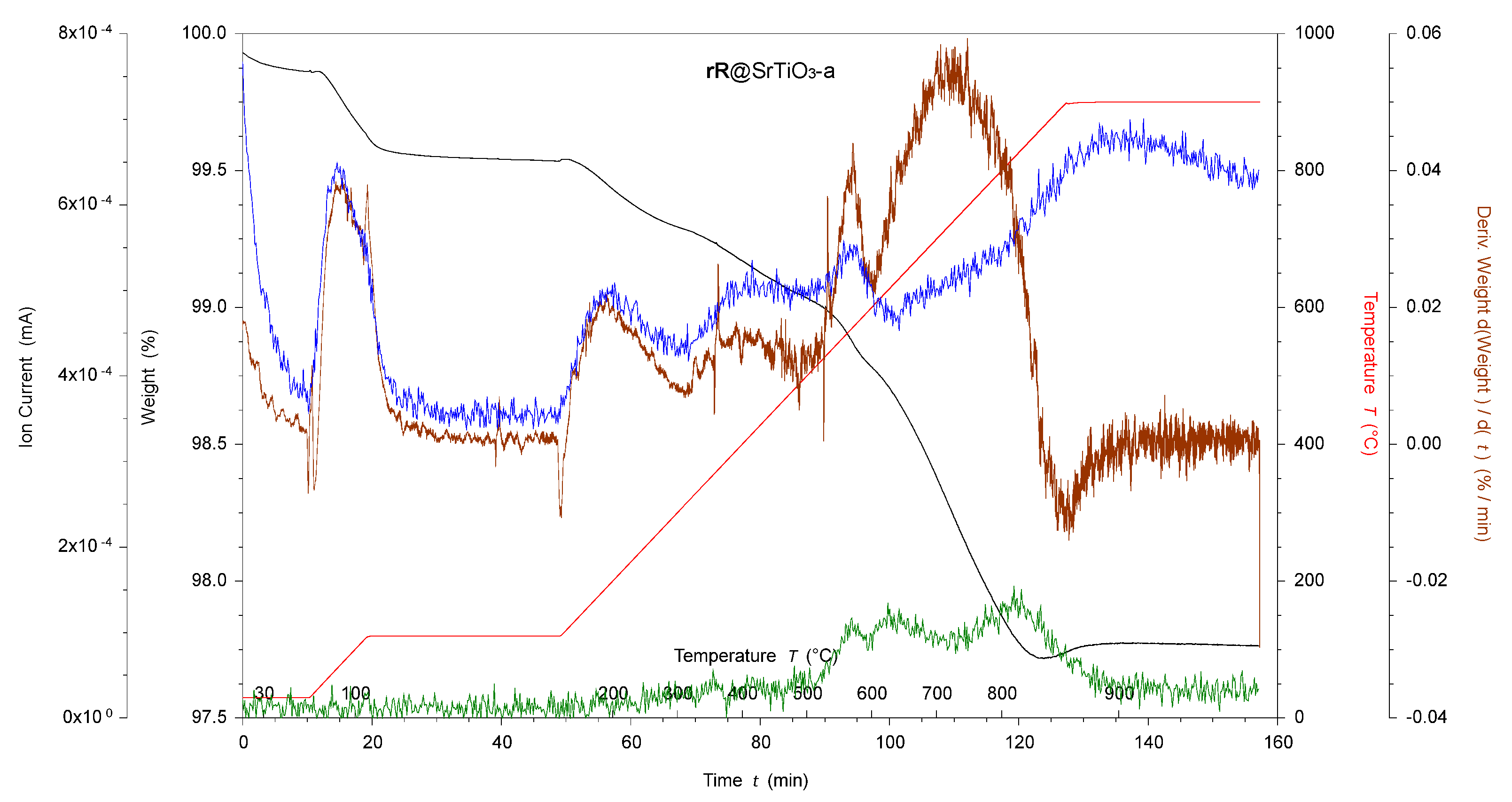
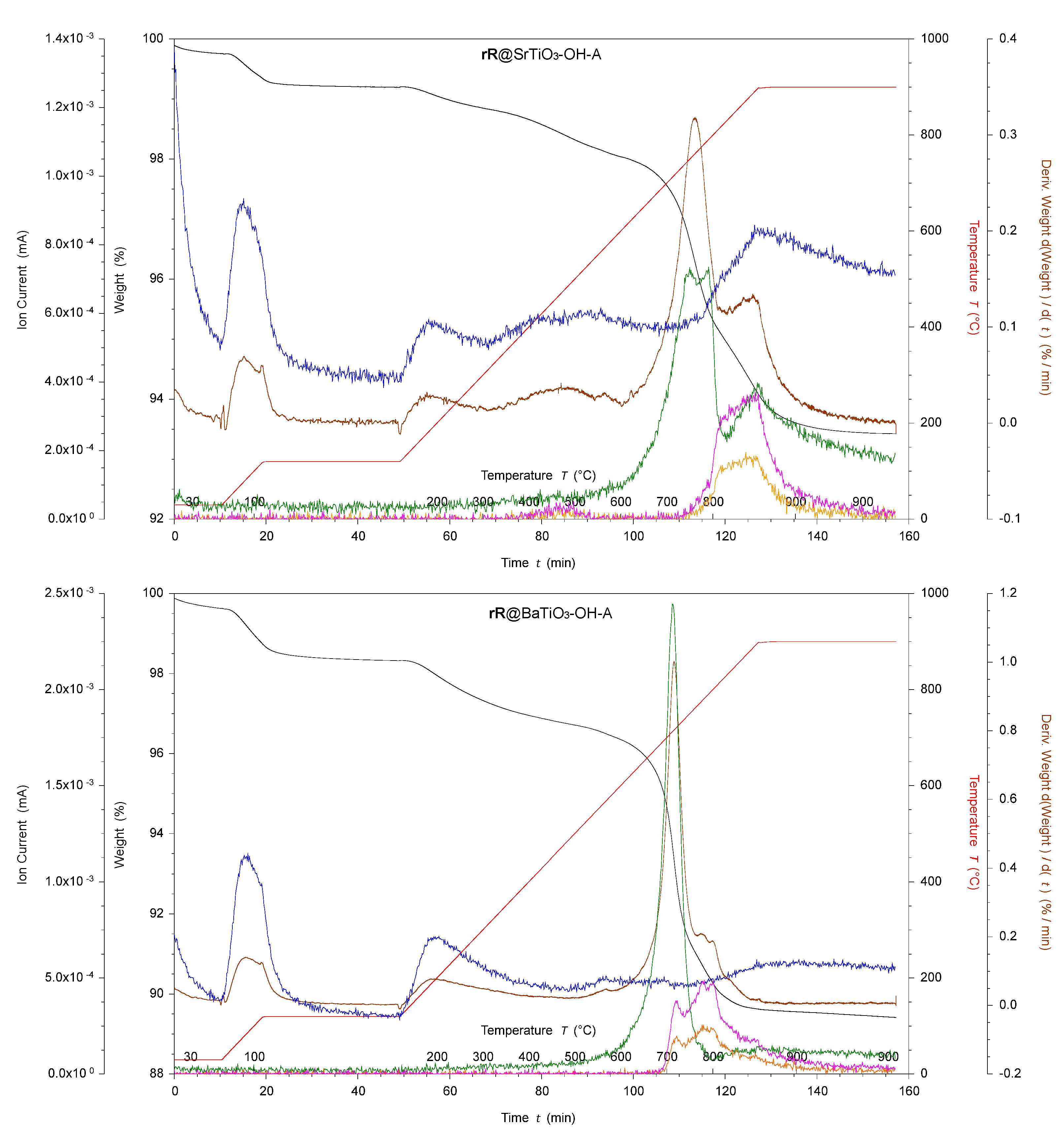
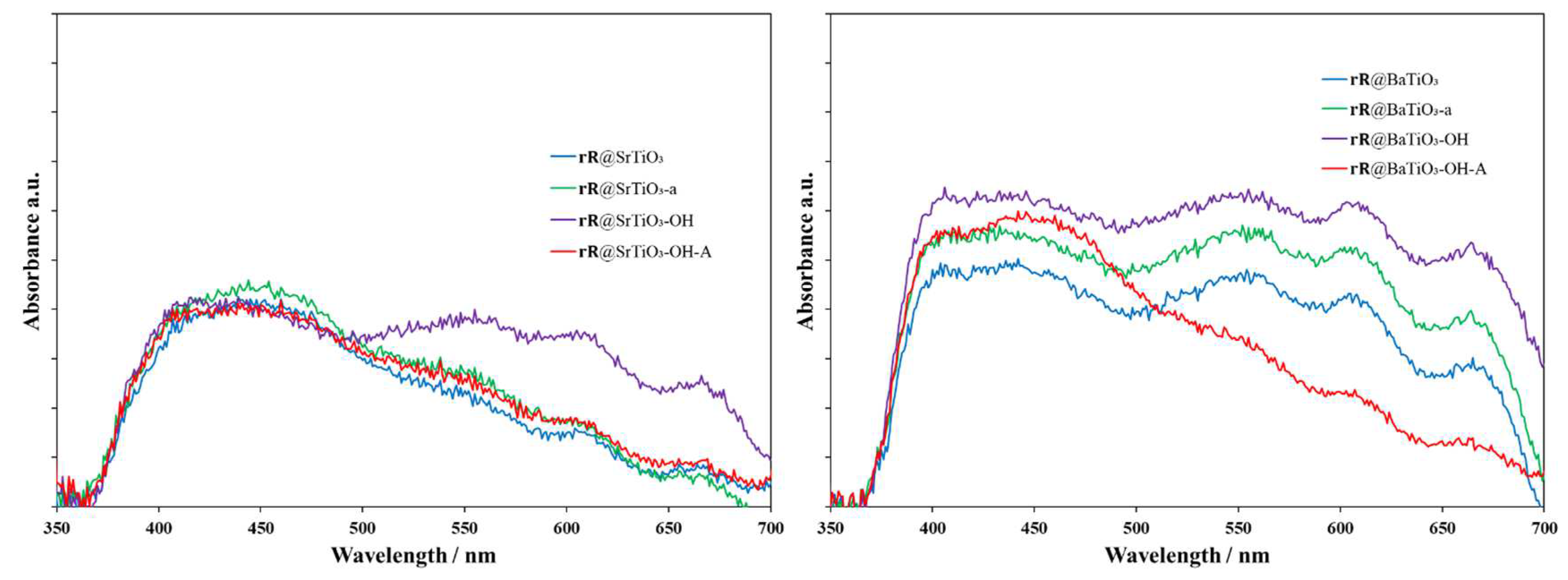
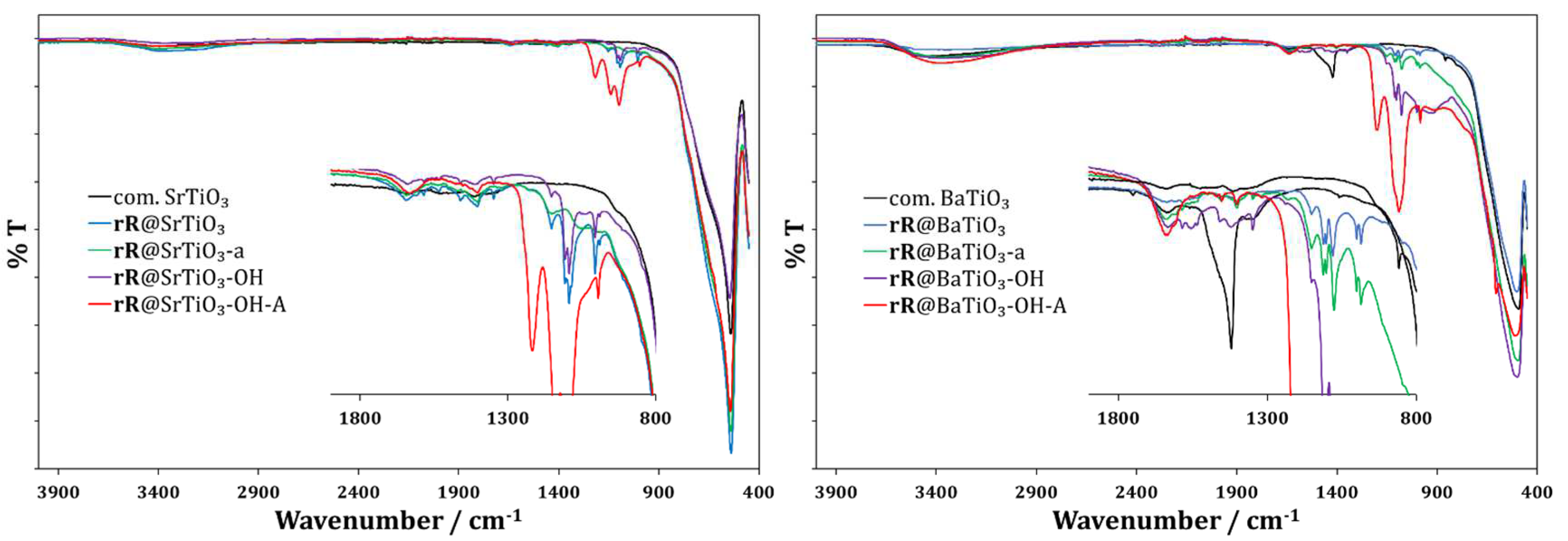
| Entry | 30–380 °C /% | Mass Found /amu | 380–900 °C /% | Mass Found /amu |
|---|---|---|---|---|
| Pristine SrTiO3 | 0.5 | 18; 44 a | 0.4 | 18; 44 |
| SrTiO3-a | 0.6 | 18 | 1.0 | 18, 44 b, 81 b |
| SrTiO3-OH | 1.8 | 18; 44 | 0.6 | 18; 44 |
| PristineBaTiO3 | 1.0 | 18; 44 | 0.6 | 18; 44 |
| BaTiO3-a | 1.4 | 18 | 0.5 | 18; 44 b |
| BaTiO3-OH | 3.6 | 18; 44 | 0.8 | 18; 44 |
| Entry | 30–380 °C /% | Mass Found /amu | 380–900 °C /% | Mass Found /amu |
|---|---|---|---|---|
| 1@SrTiO3 | 0.8 | 18 | 1.0 | 18; 44 |
| 1@SrTiO3-a | 0.6 | 18 | 1.2 | 18; 44; 81 |
| 1@SrTiO3-OH | 1.6 | 18 | 1.3 | 18; 44 |
| 1@BaTiO3 | 1.4 | 18 | 1.0 | 18; 44 |
| 1@BaTiO3-a | 1.5 | 18 | 1.2 | 18; 44; 81 |
| 1@BaTiO3-OH | 3.3 | 18 | 1.5 | 18; 44 |
| Entry | 30–380 °C /% | Mass Found /amu | 380–900 °C /% | Mass Found /amu |
|---|---|---|---|---|
| rR@SrTiO3 | 0.9 | 18; 44 | 1.5 | 18; 44 |
| rR@SrTiO3-a | 0.7 | 18; 44 | 1.4 | 18; 44 |
| rR@SrTiO3-OH | 1.5 | 18; 44 | 1.6 | 18; 44 |
| rR@SrTiO3-OH-A | 1.2 | 18 | 5.3 | 18; 44; 48; 64 |
| rR@BaTiO3 | 0.9 | 18; 44 | 1.2 | 18; 44 |
| rR@BaTiO3-a | 1.6 | 18; 44 | 1.5 | 18; 44 |
| rR@BaTiO3-OH | 3.2 | 18; 44 | 1.6 | 18; 44 |
| rR@BaTiO3-OH-A | 2.9 | 18 | 7.6 | 18; 44; 48; 64 |
| Entry | GCI a /a.u. | H2 /mL | Rate /mL h−1 |
|---|---|---|---|
| rR@SrTiO3 | 150,100 | 3.10 | 0.77 |
| rR@SrTiO3-a | 216,900 | 4.47 | 1.12 |
| rR@SrTiO3-OH | 31,800 | 0.66 | 0.16 |
| rR@SrTiO3-OH-A | 94,900 | 1.96 | 0.49 |
| rR@BaTiO3 | 43,800 | 0.90 | 0.23 |
| rR@BaTiO3-a | 90,000 | 1.86 | 0.46 |
| rR@BaTiO3-OH | 0 | 0 | 0 |
| rR@BaTiO3-OH-A | 108,600 | 2.24 | 0.56 |
Disclaimer/Publisher’s Note: The statements, opinions and data contained in all publications are solely those of the individual author(s) and contributor(s) and not of MDPI and/or the editor(s). MDPI and/or the editor(s) disclaim responsibility for any injury to people or property resulting from any ideas, methods, instructions or products referred to in the content. |
© 2023 by the authors. Licensee MDPI, Basel, Switzerland. This article is an open access article distributed under the terms and conditions of the Creative Commons Attribution (CC BY) license (https://creativecommons.org/licenses/by/4.0/).
Share and Cite
Freimann, S.A.; Housecroft, C.E.; Constable, E.C. Nanoparticulate Perovskites for Photocatalytic Water Reduction. Nanomaterials 2023, 13, 2094. https://doi.org/10.3390/nano13142094
Freimann SA, Housecroft CE, Constable EC. Nanoparticulate Perovskites for Photocatalytic Water Reduction. Nanomaterials. 2023; 13(14):2094. https://doi.org/10.3390/nano13142094
Chicago/Turabian StyleFreimann, Sven A., Catherine E. Housecroft, and Edwin C. Constable. 2023. "Nanoparticulate Perovskites for Photocatalytic Water Reduction" Nanomaterials 13, no. 14: 2094. https://doi.org/10.3390/nano13142094






